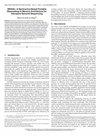DeMM: A Decoupled Matrix Multiplication Engine Supporting Relaxed Structured Sparsity
IF 1.4
3区 计算机科学
Q4 COMPUTER SCIENCE, HARDWARE & ARCHITECTURE
引用次数: 0
Abstract
Deep Learning (DL) has achieved unprecedented success in various application domains. Meanwhile, model pruning has emerged as a viable solution to reduce the footprint of DL models in mobile applications, without compromising their accuracy. To enable the matrix engines built for dense DL models to also handle their pruned counterparts, pruned DL models follow a fine-grained structured sparsity pattern of 1:4, or 2:4, whereby in each group of four contiguous values, at least one, or two, respectively, must be non-zero. Structured sparsity has recently also moved to coarser (relaxed) cases ofDeMM:支持松弛结构稀疏性的解耦矩阵乘法引擎
深度学习(DL)在各种应用领域取得了前所未有的成功。与此同时,模型剪枝已成为一种可行的解决方案,可减少移动应用中深度学习模型的占用空间,同时又不影响其准确性。为了使为密集 DL 模型构建的矩阵引擎也能处理经过剪枝的对应模型,经过剪枝的 DL 模型遵循 1:4 或 2:4 的细粒度结构稀疏性模式,即在每组四个连续值中,至少有一个或两个值必须为非零。最近,结构稀疏性也发展到了更粗糙(宽松)的 N:128 或 N:256(N 值很小)的情况,目标是为 DL 模型提供更宽的稀疏性范围(10%-90%)。在这项工作中,我们设计了一种加速器,通过构造,它可以在具有宽松结构稀疏性的宽块上运行。与传统的收缩阵列原型不同,新引擎将收缩阵列的内存部分与乘加单元解耦。内存块包括 1 个写入端口和 N 个读取端口,读取端口的数量等于每行非零元素的数量。乘加单元直接连接到每个读取端口,并按行先乘积的顺序完成乘法运算。更重要的是,简单的重新配置可实现更密集的模式。实验评估结果表明,与目前最先进的针对细粒度和宽松结构稀疏性而构建的收缩阵列引擎相比,延迟得到了大幅改善。
本文章由计算机程序翻译,如有差异,请以英文原文为准。
求助全文
约1分钟内获得全文
求助全文
来源期刊

IEEE Computer Architecture Letters
COMPUTER SCIENCE, HARDWARE & ARCHITECTURE-
CiteScore
4.60
自引率
4.30%
发文量
29
期刊介绍:
IEEE Computer Architecture Letters is a rigorously peer-reviewed forum for publishing early, high-impact results in the areas of uni- and multiprocessor computer systems, computer architecture, microarchitecture, workload characterization, performance evaluation and simulation techniques, and power-aware computing. Submissions are welcomed on any topic in computer architecture, especially but not limited to: microprocessor and multiprocessor systems, microarchitecture and ILP processors, workload characterization, performance evaluation and simulation techniques, compiler-hardware and operating system-hardware interactions, interconnect architectures, memory and cache systems, power and thermal issues at the architecture level, I/O architectures and techniques, independent validation of previously published results, analysis of unsuccessful techniques, domain-specific processor architectures (e.g., embedded, graphics, network, etc.), real-time and high-availability architectures, reconfigurable systems.
 求助内容:
求助内容: 应助结果提醒方式:
应助结果提醒方式:


